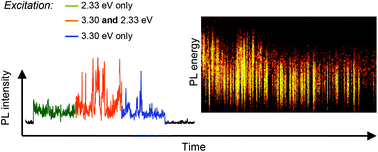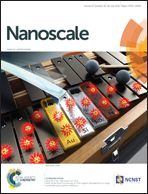Single-particle spectroscopy of I–III–VI semiconductor nanocrystals: spectral diffusion and suppression of blinking by two-color excitation†
Abstract
Ternary I–III–VI semiconductor nanocrystals have been explored as non-toxic alternatives to II–VI semiconductors for optoelectronic and sensing applications, but large photoluminescence spectral width and moderate brightness restrict their practical use. Here, using single-particle photoluminescence spectroscopy on nanocrystals of (AgIn)xZn2(1−x)S2 we show that the photoluminescence band is inhomogeneously broadened and that size distribution is the dominant factor in the broadening. The residual homogeneous linewidth of individual nanocrystals reaches up to 75% of the ensemble spectral width. Single nanocrystals undergo spectral diffusion which also contributes to the inhomogeneous band. Excitation with two lasers with energies above and below the bandgap reveals coexistence of two emitting donor states within one particle. Spectral diffusion in such particles is due to temporal activation and deactivation of one such state. Filling of a trap state with a lower-energy laser enables optical modulation of photoluminescence intermittency (blinking) and leads to an almost two-fold increase in brightness.


 Please wait while we load your content...
Please wait while we load your content...